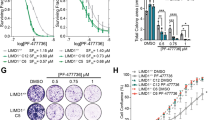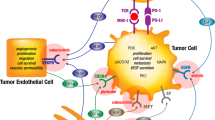Abstract
Somatic mutations that activate phosphoinositide 3-kinase (PI3K) have been identified in the p110-α catalytic subunit (encoded by PIK3CA)1. They are most frequently observed in two hotspots: the helical domain (E545K and E542K) and the kinase domain (H1047R). Although the p110-α mutants are transforming in vitro, their oncogenic potential has not been assessed in genetically engineered mouse models. Furthermore, clinical trials with PI3K inhibitors have recently been initiated, and it is unknown if their efficacy will be restricted to specific, genetically defined malignancies. In this study, we engineered a mouse model of lung adenocarcinomas initiated and maintained by expression of p110-α H1047R. Treatment of these tumors with NVP-BEZ235, a dual pan–PI3K and mammalian target of rapamycin (mTOR) inhibitor in clinical development, led to marked tumor regression as shown by positron emission tomography–computed tomography, magnetic resonance imaging and microscopic examination. In contrast, mouse lung cancers driven by mutant Kras did not substantially respond to single-agent NVP-BEZ235. However, when NVP-BEZ235 was combined with a mitogen-activated protein kinase kinase (MEK) inhibitor, ARRY-142886, there was marked synergy in shrinking these Kras-mutant cancers. These in vivo studies suggest that inhibitors of the PI3K-mTOR pathway may be active in cancers with PIK3CA mutations and, when combined with MEK inhibitors, may effectively treat KRAS mutated lung cancers.
This is a preview of subscription content, access via your institution
Access options
Subscribe to this journal
Receive 12 print issues and online access
$209.00 per year
only $17.42 per issue
Buy this article
- Purchase on Springer Link
- Instant access to full article PDF
Prices may be subject to local taxes which are calculated during checkout




Similar content being viewed by others
References
Samuels, Y. et al. High frequency of mutations of the PIK3CA gene in human cancers. Science 304, 554 (2004).
Ji, H. et al. The impact of human EGFR kinase domain mutations on lung tumorigenesis and in vivo sensitivity to EGFR-targeted therapies. Cancer Cell 9, 485–495 (2006).
Li, D. et al. Bronchial and peripheral murine lung carcinomas induced by T790M–L858R mutant EGFR respond to HKI-272 and rapamycin combination therapy. Cancer Cell 12, 81–93 (2007).
Fisher, G.H. et al. Induction and apoptotic regression of lung adenocarcinomas by regulation of a K-Ras transgene in the presence and absence of tumor suppressor genes. Genes Dev. 15, 3249–3262 (2001).
Perl, A.K., Tichelaar, J.W. & Whitsett, J.A. Conditional gene expression in the respiratory epithelium of the mouse. Transgenic Res. 11, 21–29 (2002).
Yu, J. et al. Regulation of the p85/p110 phosphatidylinositol 3′-kinase: stabilization and inhibition of the p110α catalytic subunit by the p85 regulatory subunit. Mol. Cell. Biol. 18, 1379–1387 (1998).
Fruman, D.A. et al. Impaired B cell development and proliferation in absence of phosphoinositide 3-kinase p85α. Science 283, 393–397 (1999).
Brachmann, S.M., Ueki, K., Engelman, J.A., Kahn, R.C. & Cantley, L.C. Phosphoinositide 3-kinase catalytic subunit deletion and regulatory subunit deletion have opposite effects on insulin sensitivity in mice. Mol. Cell. Biol. 25, 1596–1607 (2005).
Maira, S.-M. et al. Identification and characterization of NVP-BEZ235, a new orally available dual PI3K-mTor inhibitor with potent in vivo antitumor activity. Mol. Cancer Ther. 7, 1851–1863 (2008).
Gupta, S. et al. Binding of ras to phosphoinositide 3-kinase p110α is required for ras-driven tumorigenesis in mice. Cell 129, 957–968 (2007).
Johnson, L. et al. Somatic activation of the K-ras oncogene causes early onset lung cancer in mice. Nature 410, 1111–1116 (2001).
Luo, J. et al. Modulation of epithelial neoplasia and lymphoid hyperplasia in PTEN+/− mice by the p85 regulatory subunits of phosphoinositide 3-kinase. Proc. Natl. Acad. Sci. USA 102, 10238–10243 (2005).
Yang, Y. et al. Phosphatidylinositol 3-kinase mediates bronchioalveolar stem cell expansion in mouse models of oncogenic K-ras–induced lung cancer. PLoS ONE 3, e2220 (2008).
She, Q.B. et al. The BAD protein integrates survival signaling by EGFR/MAPK and PI3K/Akt kinase pathways in PTEN-deficient tumor cells. Cancer Cell 8, 287–297 (2005).
Mellinghoff, I.K. et al. Molecular determinants of the response of glioblastomas to EGFR kinase inhibitors. N. Engl. J. Med. 353, 2012–2024 (2005).
Sharma, S.V., Fischbach, M.A., Haber, D.A. & Settleman, J. “Oncogenic shock”: explaining oncogene addiction through differential signal attenuation. Clin. Cancer Res. 12, 4392s–4395s (2006).
Engelman, J.A. The role of phosphoinositide 3-kinase pathway inhibitors in the treatment of lung cancer. Clin. Cancer Res. 13, s4637–s4640 (2007).
Yeh, T.C. et al. Biological characterization of ARRY-142886 (AZD6244), a potent, highly selective mitogen-activated protein kinase kinase 1/2 inhibitor. Clin. Cancer Res. 13, 1576–1583 (2007).
Lievre, A. et al. KRAS mutation status is predictive of response to cetuximab therapy in colorectal cancer. Cancer Res. 66, 3992–3995 (2006).
Jhawer, M. et al. PIK3CA mutation/PTEN expression status predicts response of colon cancer cells to the epidermal growth factor receptor inhibitor cetuximab. Cancer Res. 68, 1953–1961 (2008).
Perez-Tenorio, G. et al. PIK3CA mutations and PTEN loss correlate with similar prognostic factors and are not mutually exclusive in breast cancer. Clin. Cancer Res. 13, 3577–3584 (2007).
Acknowledgements
CCSP-rtTA mice were generously provided by J. Whitsett at the University of Cincinnati. Tet-op-Kras mice were generously provided by H. Varmus (Memorial Sloan-Kettering Cancer Center). LSL-Kras G12D mice were kindly provided by T. Jacks (Massachusetts Institute of Technology). This work was supported by US National Institutes of Health (NIH) K08 grant CA120060-01 (J.A.E.), the American Association for Cancer Research (J.A.E.), the International Association for the Study of Lung Cancer (J.A.E.), NIH prostate cancer grant P01 CA089021 (L.C.C.), NIH pancreatic cancer grant P01 CA117969 (L.C.C.), NIH grant R01 GM41890 (L.C.C.), a Dana-Farber–Harvard Cancer Center Lung Cancer Specialized Program of Research Excellence (SPORE) grant P50 CA090578 (J.A.E. and K.-K.W.) and Dana-Farber–Harvard Cancer Center Gastrointestinal Cancer SPORE grants P50 CA127003 (J.A.E., R.W., U.M. and L.C.C.) and U24-CA092782 (R.W., U.M., A.R.G.). K.-K.W. was supported by NIH grants K08 AG024004, R01 CA122794 and R01 AG2400401; the Joan Scarangello Foundation to Conquer Lung Cancer; the Cecily and Robert Harris Foundation; and the Flight Attendant Medical Research Institute.
Author information
Authors and Affiliations
Contributions
J.A.E., L.C., L.C.C. and K.-K.W. developed the hypotheses, designed the experiments and wrote the manuscript. L.C. and J.A.E. executed most of the experiments other than immunohistochemistry and PET imaging. X.T., S.A.P., K.M., Y.S., R.K. and T.L. assisted with mouse work, dissections and drug treatments. K.C., A.L. and J.S. performed immunohistochemistry. A.R.G., R.U., R.W. and U.M. performed the mouse imaging studies. C.G.-E. and M.M. provided NVP-BEZ235 as well as guidance for its proper use and insights regarding experimental design. L.R.C. and R.F.P. provided pathological review of histology and immunohistochemistry.
Corresponding authors
Ethics declarations
Competing interests
C.G.-E. and M.M. are employees and stockholders of Novartis.
Supplementary information
Supplementary Text and Figures
Supplementary Figs. 1—6 and Supplementary Methods (PDF 965 kb)
Supplementary Movie 1
Reconstruction three-dimensional PET-CT images of a mouse with a p110-α H1047R–induced lung tumor before and after treatment with NVP-BEZ 235. The 18FDG PET-CT studies were obtained before and after treatment with NVP-BEZ235 35 mg/kg per day for four days. (MOV 2033 kb)
Rights and permissions
About this article
Cite this article
Engelman, J., Chen, L., Tan, X. et al. Effective use of PI3K and MEK inhibitors to treat mutant Kras G12D and PIK3CA H1047R murine lung cancers. Nat Med 14, 1351–1356 (2008). https://doi.org/10.1038/nm.1890
Received:
Accepted:
Published:
Issue Date:
DOI: https://doi.org/10.1038/nm.1890
This article is cited by
-
The role of APOBEC3B in lung tumor evolution and targeted cancer therapy resistance
Nature Genetics (2024)
-
Recent advances in non-small cell lung cancer targeted therapy; an update review
Cancer Cell International (2023)
-
Participation of protein metabolism in cancer progression and its potential targeting for the management of cancer
Amino Acids (2023)
-
A landscape of response to drug combinations in non-small cell lung cancer
Nature Communications (2023)
-
Signature-driven repurposing of Midostaurin for combination with MEK1/2 and KRASG12C inhibitors in lung cancer
Nature Communications (2023)



